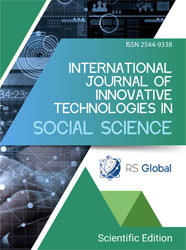BENEFITS AND RISKS OF PACIFIER USE - A NARRATIVE REVIEW ON THE MEDICAL IMPACT OF PACIFIER USE DURING INFANCY AND EARLY CHILDHOOD
Abstract
Background: Pacifier use remains a common practice during infancy and early childhood worldwide that has both benefits and risks. Its use has become highly prevalent in recent years and is sometimes considered overused, as it provides an easy and convenient method for calming and soothing children.
Objective: This review aims to summarize current scientific evidence regarding pacifier use focusing on both positive and negative outcomes to provide an overview that may help with the establishment of the clinical recommendations.
Methods: A narrative review of different randomized controlled trials and cohort studies investigating the positive and negative impacts of pacifier use such as SIDS risk, pain management, otitis media, dental malocclusions and breast-feeding.
Results: The reviewed studies indicate that pacifier use reduces risk of sudden infant death syndrome (SIDS) and is an effective way of pain management during minor medical procedures. However, evidence shows an association between pacifier use and increased incidence of acute otitis media, dental malocclusions in cases of prolonged use and negative impact on breastfeeding when introduced before lactation is well established.
Conclusion: The evidence supports selective use of pacifier, particularly during the first year of life with its introduction delayed until breastfeeding is well established, which happens usually around 1 month of age. Its use should be limited mainly to sleep periods and gradually limited by 12 months of age. Proper timing and restricted duration are key to maximising benefits while reducing risks.
References
Cinar, D.N. (2004). The advantages and disadvantages of pacifier use. Contemporary Nurse, 17(1-2), 109-12. https://doi.org/10.5172/conu.17.1-2.109
Martínez Sánchez, L., Díaz González, E., García-Tornel Florensa, S., & Gaspà Martí, J. (2000). Uso del chupete: beneficios y riesgos [Pacifier use: risks and benefits]. Anales de Pediatria, 53(6), 580-5. https://doi.org/10.1016/s1695-4033(00)77502-3
Hauck, F.R., Omojokun, O.O., & Siadaty, M.S. (2005). Do pacifiers reduce the risk of sudden infant death syndrome? A meta-analysis. Pediatrics, 116(5), e716-e723. https://doi.org/10.1542/peds.2004-2631
Garcia, D.S., & Garcia, K.W. (2025). Pacifiers: Common Questions and Answers. American Family Physician, 111(3), 230-5. Available from: https://www.aafp.org/pubs/afp/issues/2025/0300/pacifiers.html. Accessed 2025 Aug 15.
Nelson, A.M. (2012). A comprehensive review of evidence and current recommendations related to pacifier usage. Journal of Pediatrics Nursing, 27(6), 690-9. https://doi.org/10.1016/j.pedn.2012.01.004
Baby Bottle Museum. (n.d.). Dummies / Comforters. Available from: https://www.babybottle-museum.co.uk/dummy/. Accessed 2025 Aug 10.
Hanzer, M., Zotter, H., Sauseng, W., Pichler, G., Müller, W., & Kerbl, R. (2010). Non-Nutritive Sucking Habits in Sleeping Infants. Neonatology, 97(1), 61-6. https://doi.org/10.1159/000231518
Hauck, F.R., & Tanabe, K.O. (2009). SIDS. BMJ Clin Evid, 0315.
Moon, R.Y., Carlin, R.F., & Hand, I. (2022). TASK FORCE ON SUDDEN INFANT DEATH SYNDROME AND THE COMMITTEE ON FETUS AND NEWBORN. Sleep-Related Infant Deaths: Updated 2022 Recommendations for Reducing Infant Deaths in the Sleep Environment. Pediatrics, 150(1), e2022057990. https://doi.org/10.1542/peds.2022-057990
Kinney, H.C., & Thach, B.T. (2009). The sudden infant death syndrome. New English Journal of Medicine, 361(8), 795-805. https://doi.org/10.1056/nejmra0803836
Jullien, S. (2021). Sudden infant death syndrome prevention. BMC Pediatrics, 21(Suppl 1), 320. https://doi.org/10.1186/s12887-021-02536-z
Moon, R.Y., Tanabe, K.O., Yang, D.C., Young, H.A., & Hauck, F.R. (2012). Pacifier use and SIDS: evidence for a consistently reduced risk. Maternal and Child Health Journal, 16(3), 609-14. https://doi.org/10.1007/s10995-011-0793-x
Weiss, P.P., & Kerbl, R. (2001). The relatively short duration that a child retains a pacifier in the mouth during sleep: implications for sudden infant death syndrome. European Journal of Pediatrics, 160(1), 60–70. https://doi.org/10.1007/s004310000638
Engelberts, A.C., & L'Hoir, M.P. (2008). Pacifier use and SIDS. Archives of Disease in Childhood, 82(3), 267. https://doi.org/10.1136/adc.82.3.266c
Goldwater, P.N. (2024). Why do pacifiers/dummies have a protective effect in sudden infant death syndrome? A new hypothesis. Medical Hypotheses, 193, 111517. https://doi.org/10.1016/j.mehy.2024.111517
Horne, R.S.C., Fyfe, K.L., Odoi, A., Athukoralage, A., Yiallourou, S.R., & Wong, F.Y. (2016). Dummy/pacifier use in preterm infants increases blood pressure and improves heart rate control. Pediatric Research, 79, 325-32. https://doi.org/10.1038/pr.2015.212
Franco, P., Scaillet, S., Wermenbol, V., Valente, F., Groswasser, J., & Kahn, A. (2000). The influence of a pacifier on infants' arousals from sleep. The Journal of Pediatrics, 136(6), 775-9. https://doi.org/10.1016/s0022-3476(00)20580-5
Taddio, A., Goldbach, M., Ipp, M., Stevens, B., & Koren, G. (1995). Effect of neonatal circumcision on pain responses during vaccination in boys. The Lancet, 345(8945), 291-2. https://doi.org/10.1016/s0140-6736(95)90278-3
Gibbins, S., & Stevens, B. Mechanisms of Sucrose and Non‐Nutritive Sucking in Procedural Pain Management in Infants. Pain Research and Management, 6(1), 9-50. https://doi.org/10.1155/2001/376819
Corbo, M.G., Mansi, G., Stagni, A., Romano, A., van den Heuvel, J., Capasso, L., Raffio, T., Zoccali, S., & Paludetto, R. (2000). Nonnutritive Sucking during Heelstick Procedures Decreases Behavioral Distress in the Newborn Infant. Biology of Neonate, 77(3), 162-7. https://doi.org/10.1159/000014211
Curtis, S., Jou, H., Ali, S., Vandermeer, B., & Klassen, T. (2007). A randomized controlled trial of sucrose and/or pacifier as analgesia for infants receiving venipuncture in a pediatric emergency department. BMC Pediatrics, 7(27). https://doi.org/10.1186/1471-2431-7-27
Carbajal, R., Chauvet, X., Couderc, S., & Olivier-Martin, M. (1999). Randomised trial of analgesic effects of sucrose, glucose, and pacifiers in term neonates. BMJ, 319, 1393. https://doi.org/10.1136/bmj.319.7222.1393
Leung, A.K.C., & Wong, A.H.C. (2017). Acute Otitis Media in Children. Recent Patents on Inflammation Allergy Drug Discovery, 11(1), 32-40. https://doi.org/10.2174/1874609810666170712145332
Danishyar, A., & Ashurst, J.V. (2023). Acute Otitis Media. In: StatPearls. Treasure Island (FL): StatPearls Available from: https://www.ncbi.nlm.nih.gov/books/NBK470332/. Accessed 2025 Aug 21.
Harmes, K.M., Blackwood, R.A., Burrows, H.L., Cooke, J.M., Harrison, R.V., & Passamani, P.P. (2013). Otitis media: diagnosis and treatment. American Family Physician, 88(7), 435-440.
Leichtle, A., Hoffmann, T.K., & Wigand, M.C. (2018). Otitis media – Definition, Pathogenese, Klinik, Diagnose und Therapie [Otitis media: definition, pathogenesis, clinical presentation, diagnosis and therapy]. Laryngo-Rhino-Otologie, 97(7), 497-508. https://doi.org/10.1055/s-0044-101327
Ciprandi, G., Ameli, F., Asmanov, A., Passali, F.M., & Tosca, M.A. (2021). Risk factors for recurrent acute otitis media: a real-life clinical experience. Journal of Biological Regulations and Homeostatic Agents, 35(1), 33-8. https://doi.org/10.23812/21-1supp2-7
Paing, A., Elliff-O'Shea, L., Day, J., Joshi, D., Arnold, S., Brown, T.H., & Kennedy, V. (2024). Modifiable risk factors for developing otitis media with effusion in children under 12 years in high-income countries: a systematic review. Archives of Disease in Childhood, 110(1), 45-51. https://doi.org/10.1136/archdischild-2024-327454
Giebink, G.S. (1994). Preventing otitis media. Annals of Otology, Rhinology and Laryngology, 163, 20-3. https://doi.org/10.1177/00034894941030s506
Rovers, M.M., Numans, M.E., Langenbach, E., Grobbee, D.E., Verheij, T.J., & Schilder, A.G. (2008). Is pacifier use a risk factor for acute otitis media? A dynamic cohort study. Family Practice, 25(4), 233-6. https://doi.org/10.1093/fampra/cmn030
Niemelä, M., Pihakari, O., Pokka, T., & Uhari, M. (2000). Pacifier as a risk factor for acute otitis media: A randomized, controlled trial of parental counseling. Pediatrics. 106(3), 483-8. https://doi.org/10.1542/peds.106.3.483
Torretta, S., Marchisio, P., Cappadona, M., Baggi, E., & Pignataro, L. (2013). Habitual use of push and pull plastic bottle caps is more prevalent among children with recurrent acute otitis media. International Journal of Pediatric Otorhinolaryngology, 77(7), 1179-82. https://doi.org/10.1016/j.ijporl.2013.04.032
Ponti, M., Canadian Paediatric Society, & Community Paediatrics Committee. (2003). Recommendations for the use of pacifiers. Paediatrics Child Health, 8(8), 515-28. https://doi.org/10.1093/pch/8.8.515
Warren, J.J., Bishara, S.E., Steinbock, K.L., Yonezu, T., & Nowak, A.J. (2001). Effects of oral habits' duration on dental characteristics in the primary dentition. The Journal of the American Dental Association, 132(12), 1685-93. https://doi.org/10.14219/jada.archive.2001.0121
Adair, S.M., Milano, M., Lorenzo, I., & Russell, C. (1995). Effects of current and former pacifier use on the dentition of 24- to 59-month-old children. Pediatr Dent, 17(7), 437-44.
American Dental Association. (2002). Your Child’s Teeth; p. 6.
Howard, C.R., Howard, F.M., Lanphear, B., deBlieck, E.A., Eberly, S., & Lawrence, R.A. (1999). The Effects of Early Pacifier Use on Breastfeeding Duration. Pediatrics, 103(3), e33. https://doi.org/10.1542/peds.103.3.e33
Mauch, C.E., Scott, J.A., Magarey, A.M., & Daniels, L.A. (2012). Predictors of and reasons for pacifier use in first-time mothers: an observational study. BMC Pediatrics, 12(7). https://doi.org/10.1186/1471-2431-12-7
Shaki, F., Aziznejadroshan, P., Rad, Z.A., Chehrazi, M. & Arzani, A. (2022). Comparison of the effect of two methods of sucking on pacifier and mother's finger on oral feeding behavior in preterm infants: a randomized clinical trial. BMC Pediatrics, 22(1), 292. https://doi.org/10.1186/s12887-022-03352-9
Kent, J., Ashton, E., Hardwick, C., Rowan, M., Chia, E., Fairclough, K., Menon, L., Scott, C., Mather-McCaw, G., Navarro, K., & Geddes, D. (2015). Nipple Pain in Breastfeeding Mothers: Incidence, Causes and Treatments. International Journal of Environmental Research and Public Health, 12(10), 12247–63. https://doi.org/10.3390/ijerph121012247
Centuori, S., Burmaz, T., Ronfani, L., Fragiacomo, M., Quintero, S., Pavan, C., Davanzo, R., & Cattaneo, A. (1999). Nipple Care, Sore Nipples, and Breastfeeding: A Randomized Trial. Journal of Human Lactation, 15(2), 125-30. https://doi.org/10.1177/089033449901500210
Tolppola, O., Renko, M., Sankilampi, U., Kiviranta, P., Hintikka, L., & Kuitunen, I. (2022). Pacifier use and breastfeeding in term and preterm newborns—a systematic review and meta-analysis. European Journal of Pediatrics, 181(9), 3421-8. https://doi.org/10.1007/s00431-022-04559-9
Wilson, E., Woodd, S.L., & Benova, L. (2020). Incidence of and Risk Factors for Lactational Mastitis: A Systematic Review. Journal of Human Lactation, 36(4), 673-86. https://doi.org/10.1177/0890334420907898
Mannel, R. (2011). Defining Lactation Acuity to Improve Patient Safety and Outcomes. Journal of Human Lactation, 27(2), 163-70. https://doi.org/10.1177/0890334410397198
Views:
66
Downloads:
17
Copyright (c) 2025 Patrycja Ucieklak, Monika Ucieklak, Jarosław Ucieklak, Dawid Musialik, Karol Poplicha, Konrad Poplicha, Piotr Sobkiewicz, Martyna Grodzińska, Aleksandra Piech, Karolina Pasierb

This work is licensed under a Creative Commons Attribution 4.0 International License.
All articles are published in open-access and licensed under a Creative Commons Attribution 4.0 International License (CC BY 4.0). Hence, authors retain copyright to the content of the articles.
CC BY 4.0 License allows content to be copied, adapted, displayed, distributed, re-published or otherwise re-used for any purpose including for adaptation and commercial use provided the content is attributed.















